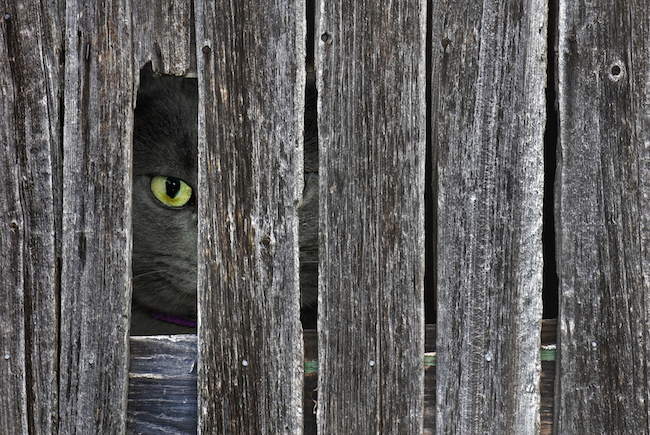
Cats tend to be explorers that are ever-curious about the places around them. Often when one person in a neighborhood does not keep tabs on his cat, another neighbor will find him digging through their garden, or swiping at the koi fish in their backyard pond. Whether the sneaky visitor is a neighbor’s pet or a hungry feral cat on the prowl looking for dinner, learn some helpful ways to keep your backyard free from impertinent pets.
Keeping Neighborhood Cats Away
Ultrasonic boundary devices: Similar to the corrective training devices, the ultrasonic boundary helps alert animals that they have gone too far or literally crossed a line. The ultrasonic sound waves can reach up to 35 feet away, causing an uncomfortable noise (that is inaudible to humans) to warn creatures to stay away or else risk unpleasantness. This might be the most advisable option if you don’t have pets (who might be greatly agitated by this if it is a small property), or if your dog or cat is primarily an indoor pet.
Motion-activated sprinkler: If the sound-emitting tool does not seem to be working, some home owners prefer to use sprinkles that switch on whenever their motion sensors go off. The sprinkler then shoots out water in the direction where the animal came from. This kind of devise is intended to frighten and discourage the intruder from proceeding past it, rather than to soak the cat completely. Though using the motion-activated sprinkler in winter is unadvisable in cold weather, using one in warm weather will help to train the animal to stay away.
Use aroma-deterrents: Some people advocate sprinkling lemon and orange peel where you find the cat droppings, as felines abhor citrus-scented objects. However, this might be counterproductive by attracting other pests such as mice or raccoons and other scavengers. Other products like “Critter Ridder” by Havahart may be a better option, since a few sprays will help chase off not only strange cats, but rabbits, deer, and other potential late-night visitors.
Physical barriers: Whether it is your kid’s sand box, or the sweet-smelling mulch you added to the flower garden, cats are often drawn to places they can eliminate or forage for food. Help discourage this behavior by creating a physical barrier, by throwing a tarp or a lockable plastic lid over the sandbox, or space might help keep the pests away from. Though this may seem tedious to do every night, the last thing you want is for your child to be exposed to the fecal matter of strange (and possible diseased or worm-ridden) animals.
Last resorts: If all your efforts to banish the backyard bandit seem to have been a waste of time, there are a few other things you can do. If you know which neighbor the cat belongs to, speak to the pet owner about keeping their kitty indoors and out of your garden. If you think it may be a feral cat, you could redirect them to a good place to eliminate, such as their own kitty litter box. Get a pail or a small box, fill it with gravel and see if they cat takes to it. After a few days, sprinkle some catnip on the surface, or rub it around the box to attract the cat’s attention on his next visit. This might help keep the kitty away from your children’s playground.
Set a trap: If a pesky feral cat keeps leaving droppings in your garden, or is eating some of your plants, try setting a trap for the next time he transgresses the limits of your fence. Once caught, take him to a rescue home or a shelter where he can be neutered/spayed and (more importantly) cared for.

